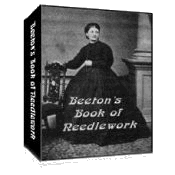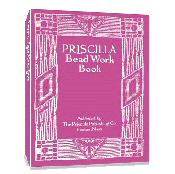Victorian Methods of Stamping a Pattern on Fabric
The following Victorian methods of stamping a pattern on fabric came from a publication that had no date. It did reference both the carriage and automobile making me believe that it was written in the early 1900’s when many people still used the horse and buggy. You will find it interesting to see how many different solutions that had to be prepared if using more than just one type of fabric. I do believe Victorian ladies would have swooned if they were to see the easy method of stamping fabric today, using specialty tracing paper and a tracing wheel found in any fabric shop all across the country.
The following are the directions given for stamping on fabric:
Place the perforated pattern (rough side up) – see Making a Perforated Pattern on the material to be stamped, placing heavy weights on the corner to keep it from slipping ; then rub stamping powder over the perforations with a piece of felt till the pattern is clearly marked on the material (this can be ascertained by lifting one corner of the pattern slightly). Then remove the pattern carefully.
Lay a piece of thin paper over the stamping and pass a hot iron over it; this melts the gum in the powder and fastens the pattern to the material. The iron should be as hot as possible without scorching the cloth. Should the heat change the color of the material, iron it all over.
Do not do any stamping by this process on a hot or damp day if it can be avoided.Keep the powder in a cool, dry place.
In stamping with light colored powders, the best way to fasten it is to hold the back of the cloth against a stove pipe or the face of the iron. French stamping is better, however, for all dark materials. To take the powder up on the distributor, have a tin plate with a piece of woolen cloth glued on the bottom, sprinkle a little powder on the cloth and rub the distributor over it, taking care to shake off all the powder you can; enough will remain to stamp the pattern clearly.
To Make a Distributor. — Make a strip of fine felt, about an inch wide (a strip from an old felt hat is as good as anything), roll it up tightly into a roll, leaving the end flat, and rub the end over a piece of sand-paper, to make it smooth and even.
To Make Blue Powder. —Take equal parts of pulverized gum damar and white rosin, and just enough Persian blue to color it ; mix well together.
Other colors are made in the same way, using for coloring chrome yellow (for light colored powder), burnt sienna, lamp black, etc. Black powder is improved by adding a little blue to it.
To Make White Powder. —Take one ounce of white lead, half an ounce of gum arabic in the impalpable powder, half an ounce of white rosin in the fine powder ; mix well together.
Superior Dark Blue Powder. — One ounce white rosin, one-half ounce gum sandarac, one-half ounce Prussian blue in fine powder; mix all thoroughly.
Black Liquid Stamping is made by putting a very little lamp black into a bottle containing benzine. Put in just enough to make it a pale black when shaken. This makes an excellent stamping liquid, as it dries as soon as applied, and will not rub off; and the patterns need no cleaning after they are used.
It must be kept corked to prevent evaporation, and away from the fire. It is used in the following manner: Take an empty spool (plug up the hole with wood) and make a distributor, by folding two or three ply of felt over one end, leaving the felt long enough to overlap part of the side of the spool, securing the felt to the spool by winding it with twine. You now place the felt end of the spool to the mouth of the bottle, and tip it upward a number of times till the distributor is well saturated. Now place the perforated pattern upon the material to be stamped (smooth side up) and rub the saturated distributor over the perforations.
French Indelible Stamping. — This is the best process for all dark materials. By this process a kind of paint is used instead of powder, and a square end brush instead of a distributor. Place the pattern on the cloth, smooth side up if you can, though either side will work well, weight the pattern down as in stamping. Rub the paint evenly over the perforations, and it will leave the lines distinct.
The paint is mixed in the following manner: Take zinc white,mix it with boiled oil to about the thickness of cream, add a little drying, such as painters use. Keep in a tin pail (one holding about a pint is a good size), have a piece of board cut round, with a screw in the center for a handle, to fit loosely into the pail; drop this on the paint and it will keep it from drying up; add a little oil occasionally to keep the paint from getting too thick, and it will always be ready for use.
After the stamping is done, the pattern must be cleaned immediately; this is done by placing the pattern on the table and turning benzine or naphtha over it to cut the paint, and then wiping the pattern dry on both sides with an old cloth. Do not use the patternfor powder stamping immediately after it has been used for the paint.
So there you have it . . . a number of Victorian ways to stamp on fabric. Are you ready to give any one of them a try?
Return to top of Stamping a Pattern page.
Return to Hand Embroidery page.
Return to Home page.



 433 pages!
433 pages!

